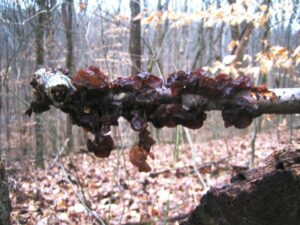By Wren Smith
There’s nothing like coming in from the cold to a warm bowl of soup! For me this is especially true if the steaming broth belongs to bowl of hot and sour soup – one balanced with heat and tang and chock-full of wood ear mushrooms!

I was away from Bernheim when we received a lovely light layer of snow on Sunday. However, the Bent Twig Trail rewarded me during a hike on Saturday with a small colony of wood ear fungi– most likely Auricularia auricular, growing on a fallen branch. Often called jelly fungi, this particular species usually appears in the moist winter woods of Bernheim. A closely related species, Auricularia polytricha, is like the one often used in the Chinese version of hot and sour soup sold in local restaurants. These fungi are collected and sold dried and shriveled, but are easily reconstituted to resume their distinctive soft, yet somewhat crisp texture. Although they have virtually no taste, it’s their texture that I find desirable in the soups. My research indicates that these local ear fungi are edible, although I have not yet tried them. Before eating any wild mushroom conduct your own research, or join a mycology group on a mushroom foray. We occasionally offer such programs at Bernheim. Mushrooms are a complicated group – many poisonous and non-poisonous mushrooms look alike, so hiking with a mushroom expert is the best way to be safe when you intend to eat them.
The genus name Auricularia has its roots in the same words for ear. Occasionally I encounter witches butter, a similar jelly like fungi that is yellow or orange in color. It is usually listed in the genus Tremella.
Mushrooms are woven in the ecological community in ways that we are only beginning to understand and appreciate. In the case of fungi, the part we see – the fruiting body – is a tiny portion of the whole. Fungi consist mostly of hidden thread-like structures known as mycelium or hypha. The network of mycelium and specialized bacteria form symbolic complex relationships know as mycorrhizal associations. Not only do they help decompose leaf litter, decay wood, and even feed small organisms, but the most fascinating to me is the role that mycorrhizal associations play in nutrient assimilation and distribution from one part of the forest to another. Mushrooms seem to have a lot to say to us, if we are willing to listen.
Want more Tales from Bent Twig? Click here to view the archive.

